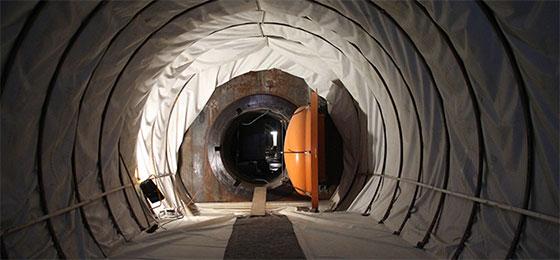Synthesis of the NRP 70 joint project "Electricity Storage via Adiabatic Air Compression"

Compressed air energy storage (CAES) covers an output and capacity range similar to that of pumped-storage systems, but offer a number of advantages.
The focus of this synthesis is adiabatic compressed air storage in Switzerland. Compressed air energy storage (CAES) covers an output and capacity range similar to that of pumped-storage systems. Compared to pumped-storage systems, CAES systems, which have a similar level of efficiency and impact on the environment, offer a number of advantages:
- No mountain valleys need to be flooded;
- Capital and operating costs are estimated to be lower and less location-dependent;
- Compressed air reservoirs work with air instead of water; they are not affected by residual flow provisions and changes in the water cycle due to climate change.
Summary
The phasing out of nuclear power plants and the expansion of solar and wind energy mean that electricity production is becoming more volatile. New storage systems are needed to ensure that electricity is available as and when it is required.
A promising technology for this purpose is adiabatic compressed air storage. It uses excess electricity from solar and wind energy systems to compress ambient air and store it in an underground cavity. When it is required, the compressed air is expanded again, driving a turbine and generating electricity once more. As the heat which was generated during compression is used for this process, the efficiency level stands at 65% to 75%, which is similar to that achieved by pumped-storage systems. The environmental compatibility of compressed air energy storage (CAES), in terms of the potential for emitting greenhouse gases and the damage inflicted on ecosystems, is also comparable to that of pumped-storage systems.
CAES systems are technically feasible. Important components such as turbomachinery and heat accumulators are either already available on the market or have been tested in a pilot plant. The process for constructing cavities is also well-developed due to the experience gained in tunnel and cavern construction.
Adiabatic CAES therefore represents an efficient, environmentally friendly and technically feasible storage solution. Due to the high capital costs and the unclear economic and legal framework conditions, however, it is uncertain whether they can be economically viable.
Recommendations
With regard to adiabatic compressed air storage, the facts are known: the technology is environmentally friendly, efficient and safe. To help it to achieve a break through, however, further measures are needed, especially from politics, energy suppliers and associations:
- Politics need to establish clear economic and legal framework conditions – and develop an “Energy Storage Strategy 2050”.
- Associations must take a more active and coordinated approach to informing politicians, businesses and the general public about energy storage systems. They should also demand clear economic and legal framework conditions for energy storage systems from politicians.
- Energy suppliers should demand clear economic and legal framework conditions from politicians – and support the research and development of new storage technologies.
- The population must be better informed about energy storage systems. Information campaigns should be implemented to increase the social acceptance of energy storage systems.
